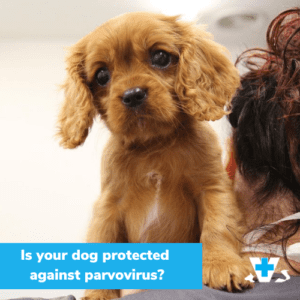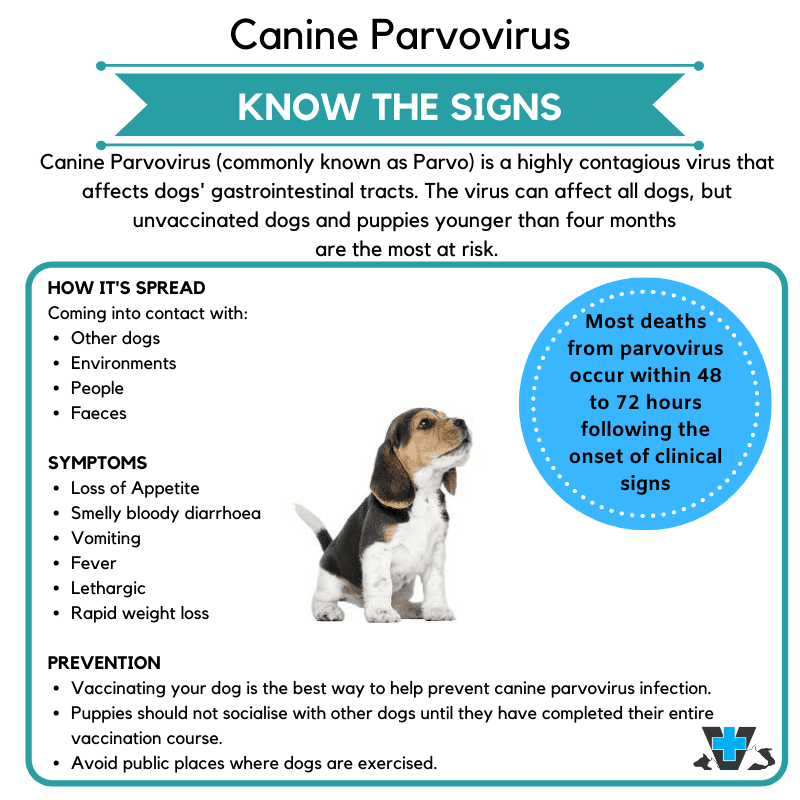More information about Parvovirus:
What is Canine Parvovirus disease?
Canine parvovirus (CPV) infection is a relatively new disease that first appeared in 1978. Because of the severity of the disease and its rapid spread through the canine population, CPV has aroused a great deal of public interest. The virus that causes it is very similar to feline enteritis, and the two diseases are almost identical. Therefore, it has been speculated that the canine virus is a mutation of the feline virus. However, that has never been proven.
How does a dog become infected with parvovirus?
The causative agent of CPV disease, as the name infers, is a virus. The main source of the virus is the faeces of infected dogs. The faeces of an infected dog can have a high concentration of viral particles. Susceptible animals become infected by ingesting the virus. Subsequently, the virus is carried to the intestine where it invades the intestinal wall and causes inflammation. Unlike most other viruses, CPV is stable in the environment and is resistant to the effects of heat, detergents, and alcohol. CPV has been recovered from dog faeces even after three months at room temperature. Due to its stability, the virus is easily transmitted via the hair or feet of infected dogs, contaminated shoes, clothes, and other objects. Direct contact between dogs is not required to spread the virus. Dogs that become infected with the virus and show clinical signs will usually become ill within 7- 10 days of the initial infection.
How does this disease affect the dog?
The clinical manifestations of CPV disease are somewhat variable, but generally take the form of severe vomiting and diarrhoea. The diarrhoea may or may not contain blood. Additionally, affected dogs often exhibit a lack of appetite, depression, and fever. It is important to note that many dogs may not show every clinical sign, but vomiting and diarrhoea are the most common signs; vomiting usually begins first. Parvo may affect dogs of all ages, but is most common in dogs less than one year of age. Young puppies less than five months of age are often the most severely affected and the most difficult to treat.
The clinical signs of CPV infection can mimic other diseases causing vomiting and diarrhoea; consequently, the diagnosis of CPV is often a challenge for the veterinary surgeon. The positive confirmation of CPV infection requires the demonstration of the virus in the faeces or the detection of anti-CPV antibodies in the blood serum. Occasionally, a dog will have parvovirus but test negative for virus in the faeces.
As with any virus disease there is no treatment to kill the virus once it infects the dog. However, the virus does not directly cause death; rather, it causes loss of the lining of the intestinal tract. This results in severe dehydration, electrolyte (sodium and potassium) imbalances, and infection in the bloodstream (septicaemia). It is when the bacteria that normally live in the intestinal tract are able to get into the blood stream, that it becomes more likely that the animal will die. The first step in treatment is to correct dehydration and electrolyte imbalances. This requires the administration of intravenous fluids containing electrolytes. Antibiotics and anti-inflammatory drugs are given to prevent or control septicemia. Antispasmodic drugs are used to inhibit the diarrhoea and vomiting that perpetuate the problems. The cost of treatment is up to $2000.
Most dogs with CPV infection recover if aggressive treatment is used and if therapy is begun before severe septicaemia and dehydration occur. For reasons not fully understood, some breeds, notably the Rottweiler, have a much higher fatality rate than other breeds.
The best method of protecting your dog against CPV infection is proper vaccination. Puppies receive a parvo vaccination as part of the vaccines given from 6 and about 12 weeks of age. In some situations, veterinary surgeons will give the vaccine at two week intervals and an additional booster at 18 to 20 weeks of age. After the initial series of vaccinations when the dog is a puppy, all dogs should be boosted one year after the puppy course has been given. The final decision about a proper vaccination schedule should be made by your veterinary surgeon.
The stability of the CPV in the environment makes it important to properly disinfect contaminated areas. This can be accomplished by cleaning food bowls, water bowls, and other contaminated items with a solution of 250 mL of chlorine bleach in 5 litres of water. It is important that chlorine bleach or glutaraldehyde based disinfectants be used because many other “viricidal” disinfectants will not kill the canine parvovirus.
It is important to note that at the present time, there is no evidence to indicate that CPV is transmissible to cats or humans.


